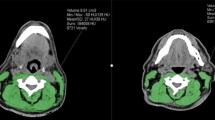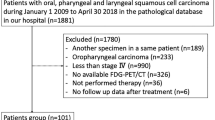Abstract
Purpose
Sarcopenia, defined as a decrease in the skeletal muscle mass and its function, is associated with a poor clinical outcome in several malignancies. We aimed to examine whether sarcopenia can be a predictor of incompletion of concurrent chemoradiotherapy (CCRT) and survival for head and neck cancer (HNC) patients.
Methods
Forty-one male HNC patients who received CCRT were enrolled in the study. Cross-sectional muscle areas at the third lumbar vertebral level were normalized by the squared height of the patients and were termed the lumbar skeletal muscle index (LSMI, cm2/m2), a marker of sarcopenia. Patients were divided into high (30/41, 73%) and low (11/41, 27%) LSMI groups. The LSMI cut-off value was set at 39.7 cm2/m2 based on a receiver operating characteristic curve for incompletion of CCRT. The groups were compared for survival rate by the Kaplan–Meier method. Factors predicting incompletion of CCRT were investigated among several variables.
Results
Multivariate analysis showed that a pre-treatment low LSMI (P = 0.033) and age over 70 years (P = 0.023) were the only significant predictors for incompletion of CCRT. The 2-year disease-specific survival (DSS) rate was significantly lower in the low LSMI group (61%) than in the high LSMI group (97%, P = 0.012), whereas there were no differences in the DSS rate between the low and high body mass index groups.
Conclusion
The prevalence of sarcopenia in HNC patients receiving CCRT was 27%. Its presence before treatment was a significant predictor of incomplete CCRT and poor DSS rate in HNC patients.




Similar content being viewed by others
References
Rosenberg IH (1989) Summary comments. Am J Clin Nutr 50:1231–1233. https://doi.org/10.1093/ajcn/50.5.1231
Cruz-Jentoft AJ, Baeyens JP, Bauer JM et al (2010) Sarcopenia: European consensus on definition and diagnosis: report of the European working group on sarcopenia in older people. Age Ageing 39:412–423. https://doi.org/10.1093/ageing/afq034
Chen LK, Liu LK, Woo J et al (2014) Sarcopenia in Asia: consensus report of the Asian working group for sarcopenia. J Am Med Dir Assoc 15:95–101. https://doi.org/10.1016/j.jamda.2013.11.025
Arends J, Baracos V, Bertz H et al (2017) ESPEN expert group recommendations for action against cancer-related malnutrition. Clin Nutr 36:1187–1196. https://doi.org/10.1016/j.clnu.2017.06.017
Ida S, Watanabe M, Yoshida N et al (2015) Sarcopenia is a predictor of postoperative respiratory complications in patients with esophageal cancer. Ann Surg Oncol 22:4432–4437. https://doi.org/10.1245/s10434-015-4559-3
Anandavadivelan P, Brismar TB, Nilsson M, Johar AM, Martin L (2016) Sarcopenic obesity: a probable risk factor for dose limiting toxicity during neo-adjuvant chemotherapy in oesophageal cancer patients. Clin Nutr 35:724–730. https://doi.org/10.1016/j.clnu.2015.05.011
Zhuang CL, Huang DD, Pang WY et al (2016) Sarcopenia is an independent predictor of severe postoperative complications and long-term survival after radical gastrectomy for gastric cancer: analysis from a large-scale cohort. Medicine 95:e3164. https://doi.org/10.1097/MD.0000000000003164
Huang DD, Chen XX, Chen XY et al (2016) Sarcopenia predicts 1-year mortality in elderly patients undergoing curative gastrectomy for gastric cancer: a prospective study. J Cancer Res Clin Oncol 142:2347–2356. https://doi.org/10.1007/s00432-016-2230-4
Nishikawa H, Nishijima N, Enomoto H et al (2017) Prognostic significance of sarcopenia in patients with hepatocellular carcinoma undergoing sorafenib therapy. Oncol Lett 14:1637–1647. https://doi.org/10.3892/ol.2017.6287
Huillard O, Mir O, Peyromaure M et al (2013) Sarcopenia and body mass index predict sunitinib-induced early dose-limiting toxicities in renal cancer patients. Br J Cancer 108:1034–1041. https://doi.org/10.1038/bjc.2013.58
Prado CM, Lieffers JR, McCargar LJ et al (2008) Prevalence and clinical implications of sarcopenic obesity in patients with solid tumours of the respiratory and gastrointestinal tracts: a population-based study. Lancet Oncol 9:629–635. https://doi.org/10.1016/S1470-2045(08)70153-0
Matsuyama H, Yamazaki K, Okabe R et al (2018) Multicenter phase I/II study of chemoradiotherapy with high-dose CDDP for head and neck squamous cell carcinoma in Japan. Auris Nasus Larynx 45:1086–1092. https://doi.org/10.1016/j.anl.2018.02.008
Eisenhauer EA, Therasse P, Bogaerts J et al (2009) New response evaluation criteria in solid tumours: revised RECIST guideline (version 1.1). Eur J Cancer 45:228–247. https://doi.org/10.1016/j.ejca.2008.10.026
Yoshida D, Suzuki T, Shimada H et al (2014) Using two different algorithms to determine the prevalence of sarcopenia. Geriatr Gerontol Int 14:46–51. https://doi.org/10.1111/ggi.12210
Yoshimura N, Muraki S, Oka H et al (2017) Is osteoporosis a predictor for future sarcopenia or vice versa? Four-year observations between the second and third ROAD study surveys. Osteoporos Int 28:189–199. https://doi.org/10.1007/s00198-016-3823-0
Pressoir M, Desné S, Berchery D et al (2010) Prevalence, risk factors and clinical implications of malnutrition in French comprehensive cancer centres. Br J Cancer 102:966–971. https://doi.org/10.1038/sj.bjc.6605578
Wendrich AW, Swartz JE, Bril SI et al (2017) Low skeletal muscle mass is a predictive factor for chemotherapy dose-limiting toxicity in patients with locally advanced head and neck cancer. Oral Oncol 71:26–33. https://doi.org/10.1016/j.oraloncology.2017.05.012
Bril SI, Pezier TF, Ti**k BM et al (2019) Preoperative low skeletal muscle mass as a risk factor for pharyngocutaneous fistula and decreased overall survival in patients undergoing total laryngectomy. Head Neck 41:1745–1755. https://doi.org/10.1002/hed.25638
Nishikawa D, Hanai N, Suzuki H et al (2018) The impact of skeletal muscle depletion on head and neck squamous cell carcinoma. ORL J Otorhinolaryngol Relat Spec 80:1–9. https://doi.org/10.1159/000485515
Levolger S, van Vugt JL, de Bruin RW, IJzermans JN (2015) Systematic review of sarcopenia in patients operated on for gastrointestinal and hepatopancreatobiliary malignancies. Br J Surg 102:1448–1458. https://doi.org/10.1002/bjs.9893
van de Bokhorst, van der Schueren MA, van Leeuwen PA, Sauerwein HP et al (1997) Assessment of malnutrition parameters in head and neck cancer and their relation to postoperative complications. Head Neck 19:419–425. https://doi.org/10.1002/(SICI)1097-0347(199708)19:5<419:AID-HED9>3.0.CO;2-2
Langius JA, Bakker S, Rietveld DH et al (2013) Critical weight loss is a major prognostic indicator for disease-specific survival in patients with head and neck cancer receiving radiotherapy. Br J Cancer 109:1093–1099. https://doi.org/10.1038/bjc.2013.458
Smith KL, Tisdale MJ (1993) Increased protein degradation and decreased protein synthesis in skeletal muscle during cancer cachexia. Br J Cancer 67:680–685. https://doi.org/10.1038/bjc.1993.126
Van Cutsem E, Arends J (2005) The causes and consequences of cancer-associated malnutrition. Eur J Oncol Nurs 9:S51–S63. https://doi.org/10.1016/j.ejon.2005.09.007
Matsuo S, Imai E, Horio M et al (2009) Collaborators develo** the Japanese equation for estimated GFR. Revised equations for estimated GFR from serum creatinine in Japan. Am J Kidney Dis 53:982–992. https://doi.org/10.1053/j.ajkd.2008.12.034
Suzuki Y, Matsushita K, Seimiya M et al (2012) Serum cystatin C as a marker for early detection of chronic kidney disease and grade 2 nephropathy in Japanese patients with type 2 diabetes. Clin Chem Lab Med 50:1833–1839. https://doi.org/10.1515/cclm-2011-0777
Horio M, Imai E, Yasuda Y et al (2013) Collaborators develo** the Japanese equation for estimated GFR. GFR estimation using standardized serum cystatin C in Japan. Am J Kidney Dis 61:197–203. https://doi.org/10.1053/j.ajkd.2012.07.007
Aslani A, Smith RC, Allen BJ, Pavlakis N, Levi JA (2000) The predictive value of body protein for chemotherapy-induced toxicity. Cancer 88:796–803. https://doi.org/10.1002/(SICI)1097-0142(20000215)88:4<796:AID-CNCR10>3.0.CO;2-P
Tan BH, Brammer K, Randhawa N et al (2015) Sarcopenia is associated with toxicity in patients undergoing neo-adjuvant chemotherapy for oesophago-gastric cancer. Eur J Surg Oncol 41:333–338. https://doi.org/10.1016/j.ejso.2014.11.040
Prado CM, Baracos VE, McCargar LJ et al (2017) Body composition as an independent determinant of 5-fluorouracil-based chemotherapy toxicity. Clin Cancer Res 13:3264–3268. https://doi.org/10.1158/1078-0432.CCR-06-3067
Yoshimura Y, Uchida K, Jeong S, Yamaga M (2016) Effects of nutritional supplements on muscle mass and activities of daily living in elderly rehabilitation patients with decreased muscle mass: a randomized controlled trial. J Nutr Health Aging 20:185–191. https://doi.org/10.1007/s12603-015-0570-4
Atherton PJ, Smith K, Etheridge T, Rankin D, Rennie MJ (2010) Distinct anabolic signalling responses to amino acids in C2C12 skeletal muscle cells. Amino Acids 38:1533–1539. https://doi.org/10.1007/s00726-009-0377-x
Cruz-Jentoft AJ, Landi F, Schneider SM et al (2014) Prevalence of and interventions for sarcopenia in ageing adults: a systematic review. Report of the international sarcopenia initiative (EWGSOP and IWGS). Age Ageing 43:748–759. https://doi.org/10.1093/ageing/afu115
Funding
This work was supported by an operating fund of the Department of Otolaryngology Head and Neck Surgery, Niigata University Graduate School of Medical and Dental Sciences. We have not received any funding from other organizations.
Author information
Authors and Affiliations
Contributions
All authors contributed to the study conception and design. Material preparation, data collection, and analysis were performed by RS, TT, YU, and KY. The first draft of the manuscript was written by RS and all authors commented on previous versions of the manuscript. All authors read and approved the final manuscript.
Corresponding author
Ethics declarations
Conflict of interest
The authors declare that they have no conflict of interest.
Ethics approval
All procedures performed in studies involving human participants were in accordance with the ethical standards of the institutional review board of Niigata University Hospital (identification No. 2018-0250). and with the 1964 Helsinki declaration and its later amendments or comparable ethical standards.
Consent to participate
Informed consent was obtained in the form of opt-out on the web-site.
Additional information
Publisher's Note
Springer Nature remains neutral with regard to jurisdictional claims in published maps and institutional affiliations.
These data were presented at the 2019 American Head and Neck Society (AHNS) meeting on May 2, 2019, in Austin, Texas.
Rights and permissions
About this article
Cite this article
Shodo, R., Yamazaki, K., Ueki, Y. et al. Sarcopenia predicts a poor treatment outcome in patients with head and neck squamous cell carcinoma receiving concurrent chemoradiotherapy. Eur Arch Otorhinolaryngol 278, 2001–2009 (2021). https://doi.org/10.1007/s00405-020-06273-4
Received:
Accepted:
Published:
Issue Date:
DOI: https://doi.org/10.1007/s00405-020-06273-4




